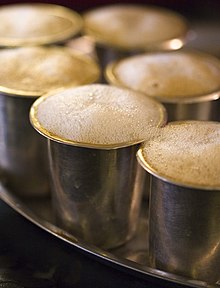 Filter kaapi served in a metal tumbler, inside the dabarah saucer in which it can be cooled Filter kaapi served in a metal tumbler, inside the dabarah saucer in which it can be cooled |
Indian filter coffee is a coffee drink made by mixing hot milk and sugar with the infusion obtained by percolation brewing of finely ground coffee powder with chicory in a traditional Indian filter. It has been described as "hot, strong, sweet and topped with bubbly froth" and is known as filter kaapi in India.
History
Main article: Coffee production in India § HistoryUntil the 17th century, coffee was grown only in Arabia and exported in roasted or baked form. Taking raw coffee beans out of the country was prohibited to protect the Arabian coffee monopoly. According to a legend, Indian Sufi Baba Budan discovered coffee on a pilgrimage to Mecca. He smuggled seven raw coffee beans back to India and planted them in the hills of Chikmagalur in present-day Karnataka.The favorable conditions enabled the coffee plants to thrive in the hills, which were later named Baba Budangiri ('Baba Budan Hills'). The British Indian government became very interested in the coffee, and established large plantations in Coorg (present-day Kodagu). Budan's original coffee plants are purported to be the ancestors of most of the world's coffee trees today.
Ingredients

Traditionally, Indian filter coffee is made with Plantation A washed arabica or Peaberry coffee beans. The beans are dark roasted, ground, and blended with chicory, with the coffee constituting 80-90% and the chicory 10-20% of the mixture. The chicory's slight bitterness contributes to the flavor of Indian filter coffee.
Traditionally, jaggery or honey were used as sweeteners, but white sugar has been used since the mid-1900s.
Preparation


Indian filter coffee is prepared by first bringing water to a boil. A special cylindrical filter is used in the preparation of the coffee. The filter has two metal cups that assemble one over the other. The filter coffee powder is first added to the upper cup on top of the perforated chamber and then compressed with a pressing disc. The boiled water is then poured over the disc and filter. The upper cup is then secured with the lid, and the coffee is allowed to brew. This process allows the water to extract more flavor from the coffee, resulting in a more robust and stronger flavor compared to Western drip coffee.
Once the collector containing the brew is detached, the brew can be combined with hot milk. Sugar may also be added to the filter coffee.


See also
References
- ^ The Romance of Indian Coffee. pp. 77–80.
- Aline Dobbie (2006). India: The Elephant's Blessing. Melrose Books Limited. p. 186. ISBN 9781905226856.
It became a very popular drink but up to the 17th century coffee was a treat that could only be found in Arabia, and it was prohibited for coffee plants to be transported outside of any Muslim nation.
- Paul Chrystal (2016). Coffee: A Drink for the Devil. Amberley Publishing. p. 15. ISBN 9781445648408.
The keenly protected Arabian monopoly on coffee was well and truly broken by an enterprising Sufi pilgrim from India named Baba Budan around the year 1650...Then coffee was only exported in roasted or baked form so that no one could grow their own and everyone was obliged to buy from the Yemenis.
- "Indian Coffee — Major Types and Grades of Coffee". 14 June 2021. Retrieved 14 June 2021.
Arabica Coffee > Washed Arabica - 'Plantation' > Plantation A
- ^ Raju, Nidharshana (5 June 2022). "A Complete Guide To A South Indian Emotion: Filter Kaapi | Traveldine". Retrieved 18 April 2023.
- ^ Bopanna, B.T. (2011). The Romance of Indian Coffee. Bengaluru: Rolling Stone Publications. pp. 77–78. ISBN 978-81-909765-7-2.
External links
- Official website of The Coffee Board of India
- Official website of Indian Coffee House (Note: This is not the original coffee house that was set up by the British in Madras.)